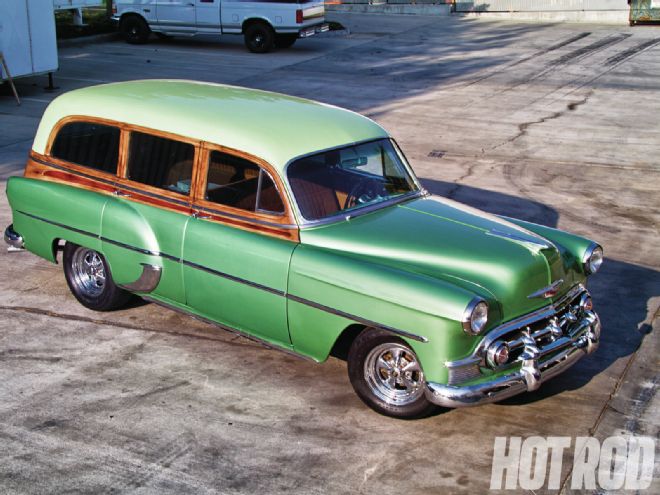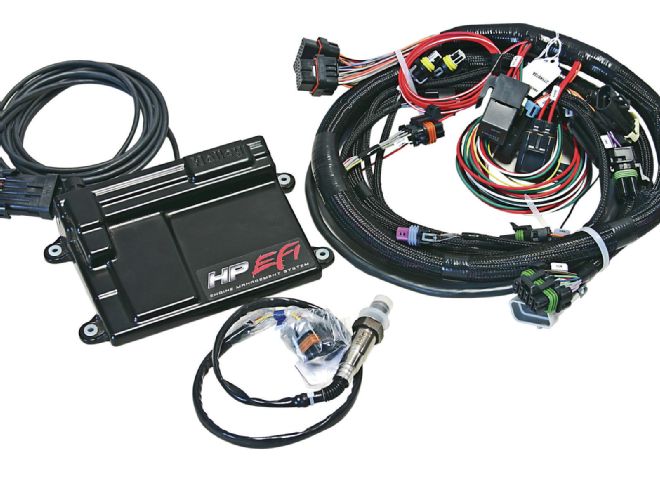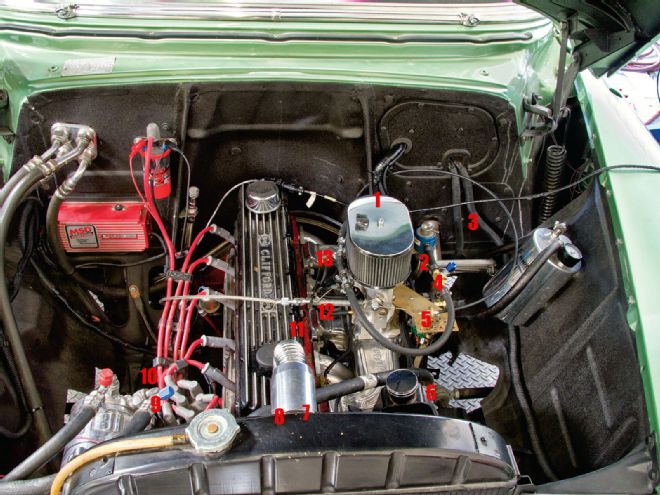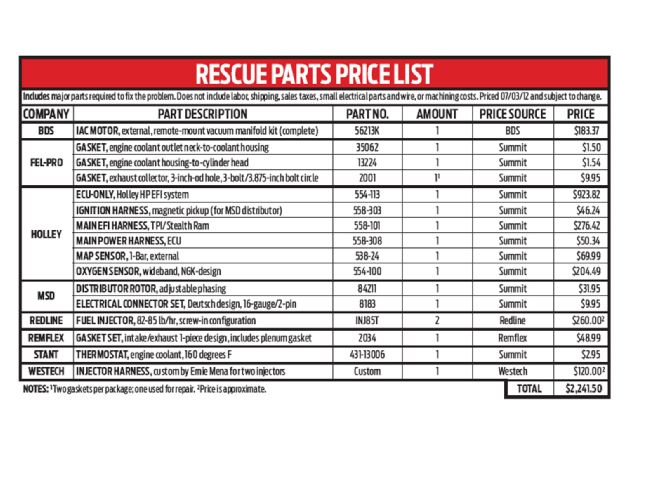
Tom Weaver dreamed of having a reliable, nostalgia-style cruiser that would be equally at home at the local Saturday night drive-in or on the cross-country Power Tour®, so he a dropped a 12,000-mile '70 Chevy 250 straight-six into a '53 Chevy tin woody. A TH350 with a stock torque converter transfers the power back to a Nova 10-bolt with 3.36:1 gears. Slightly warmed over, Weaver's mill retains the stock short-block and head but is enhanced by a header and a performance two-barrel intake from Clifford Performance, along with an MSD distributor, coil, and 6AL ignition box.
Weaver elected to install an electronic fuel-injection (EFI) system for good driveability, selecting a Weber/Redline throttle-body injection setup both for its nostalgia appearance (externally, it looks like a Weber carb) and ostensible simplicity compared with a port-injection system. That's when the nightmare began. No one--not even a Weber tech doctor who drove out for a house call--could ever get the car to run right.
"There were cold-start problems," relates Tom. "It was way too rich at idle. I couldn't get the car to even start up and run. The Weber guy at least got it running. But it was still rough. There is hesitation when you get on the gas. It smells rich all the time. It lurches and rattles under cruise."
We sent the Hemet, California–based car (on a trailer) to Westech Performance in Mira Loma, California, where ace technician Ernie Mena attempted to dial it in on the shop's SuperFlow chassis dyno.
Mena could barely get the car to run at all. At first, he thought the root cause was several exhaust-system leaks that were driving the oxygen (Ov(2)) sensor nuts. But when Mena attempted to temporarily bypass the confused sensor and manually program the computer's fuel cells, the changed data refused to stick, with the computer reverting to its default settings. "Changing the VE table--the main fuel map for this computer--produced no change in air/fuel ratio," Mena explained. According to Weaver, the computer had already been replaced once by another shop, obviously to no avail.
Further checks also revealed a badly located coolant temperature sensor (CTS), a cracked thermostat, undersized fuel injectors, and overall bad wiring, splicing, and grounds. Even if yet another replacement computer functioned properly, Mena felt the basic system architecture was marginal for getting the job done. "It doesn't control the spark," Mena said. "There's no idle air control (IAC) functionality, either." His solution: retain the nostalgia-style Weber throttle-body unit but upgrade the control system to a modern and reliable Holley HP EFI engine management system, revise the sensor suite, dial in the wiring, and repair the exhaust leaks.
Mena has worked on (and programmed) just about every EFI system. He says Holley's versatile HP EFI is currently the "most user-friendly aftermarket system out there. I like the fact that the Holley system is simplified with an integrated harness and easily adapts to a wide variety of applications. The overall system appearance is nicer, and its software is very detailed and easy to navigate. It lets you control more things, including water/methanol injection and boosted engines." The Holley system features a self-tuning capability, enabling the end user to get most engines to at least start up and run. But not so for this unique combo; Mena had to build the maps from scratch.
Several sensors were changed, relocated, or upgraded to work with Holley's system:
The Weber's proprietary, in-computer Manifold Air Pressure (MAP) sensor was replaced by a generic, industry-standard, remotely-mounted MAP sensor.
The original narrow-band Ov(2) unit was replaced by a modern wide-band sensor for much finer air/fuel ratio corrections.
The CTS was relocated to the thermostat housing for more accurate temperature readings.
An external Blower Drive Service (BDS) IAC kit was added to stabilize cold-start idle and prevent stalling.
The Weber's air temperature sensor (ATS), mounted on the air-cleaner lid, was deleted. Mena says it wasn't needed. "There was no forced induction, and the Holley system has so much other info in the computer it wasn't needed to tune the car correctly. If you do use an ATS, it should be mounted on the intake manifold, not the lid."
The distributor advance was locked out and the MSD box and distributor rewired so the Holley system could fully control the ignition timing and spark management.
The original fuel injectors were too small, even for Weaver's mild motor. Apparently, they were deliberately spec'd undersize to avoid perceived fuel puddling and distribution problems downstairs when using a single throttle-body on the Clifford intake. In Mena's opinion, that's just asking for trouble if Weaver ever seriously elected to get on the throttle (or even make a long uphill climb towing a trailer).
 Holley HP EFI usually comes as an integrated kit, supplying all parts needed for running a direct-port EFI system. But for oddball combos such as Weaver's two-nozzle TBI unit, the versatile design's modular configuration lets the end user order individual components as needed for the application. Holley HP EFI parts used on the '53 include the main ECU, assorted harnesses, and sensors.
Holley HP EFI usually comes as an integrated kit, supplying all parts needed for running a direct-port EFI system. But for oddball combos such as Weaver's two-nozzle TBI unit, the versatile design's modular configuration lets the end user order individual components as needed for the application. Holley HP EFI parts used on the '53 include the main ECU, assorted harnesses, and sensors.
Unfortunately, Weaver's older-model Weber throttle-body uses unique, screw-in injectors. Immediate availability can be problematic. Mena settled on seemingly huge 82-lb/hr injectors--theoretically capable of supporting more than 260 hp when used as a pair--because they were available and when tested exhibited a desirable conical spray pattern. Despite their size, the modern Holley computer's fuel map has enough fine control to deal with it. "Huge injectors are not the problem they once were," Mena maintains. "Today's software is much better down low. The new injectors will provide a safety margin on the top end, even if Weaver adds more stuff in the future."
Two exhaust leaks prevented proper Ov(2) sensor operation. While it was easy to repair a leaking collector-to-exhaust pipe flange gasket with a Fel-Pro heavy-duty flange gasket, it was a bear to stop the header-flange-to-cylinder-head exhaust leak. On a Chevy straight-six, some of the same studs and spacers retain both the intake manifold and the exhaust manifold or headers, all with a common gasket. Using factory parts, this works OK because the stockers have a uniform thickness for even clamping (their mounting flanges are dead flat, too). Aftermarket intakes and header-flange thicknesses may be inconsistent, generating nearly irreparable leaks. After unsuccessfully trying several different brands of gaskets, Mena finally cured the problem with a trick Remflex flexible graphite gasket, plus homemade Belleville-spring washers for extra clamping force.
 After Westech installed Holley's HP EFI on Weaver's 12,000-mile '70 Chevy 250 L6 and fixed the exhaust leaks, the engine purred like a kitten. Although the Weber throttle-body was retained, larger EFI nozzles, sensor changes, and distributor mods were needed to integrate the new setup. The engine-bay callout numbers correspond to the accompanying detail photos.
After Westech installed Holley's HP EFI on Weaver's 12,000-mile '70 Chevy 250 L6 and fixed the exhaust leaks, the engine purred like a kitten. Although the Weber throttle-body was retained, larger EFI nozzles, sensor changes, and distributor mods were needed to integrate the new setup. The engine-bay callout numbers correspond to the accompanying detail photos.
1. ATS Deleted 2. Wide-Bando2 Sensor:19 3. Wire Harness Mods:20 4. Iac Motor Added:11 5. New Map Sensor:10 6. CTS Switch Moved:12,13 7. CTS Switch Moved:12,13 8. Thermostat Repaired:14 9. Distributer Locked Out:1,2,3,4 10. Distributer Connector:5 11. Belleville Spring Washers: 16,17,18 12. Exhaust Gasket Fixed:15 13. Large Injectors: 6,7,8,9
With the exhaust leak repaired and the Holley HP EFI system wired and ready to run, Mena made a preliminary fuel map. The system started right up ("the first time ever," Weaver says). After final tuning, the engine made 112 hp and 174 lb-ft at the rear wheels, about right for a 180 to 200hp flywheel estimate. Mena summarizes, "This car fires up fine in the morning. You just turn the key and it does everything it's supposed to do." And while the car arrived at Westech on a trailer, it left under its own power. Weaver says, "I was able to drive the '53 home. It ran like a champ. The 45 miles home is the most I have put on the car in the last six years!"
If your car has a gremlin that just won't quit, you could be chosen for Hot Rod to the Rescue. Email us at pitstop@HotRod.com and put "Rescue" in the subject line. Include a description of your problem, your location, and a daytime phone number.

Whether 200 or 2,000 hp, two nozzles or 16 nozzles, the same nozzle-sizing rules apply: You need to know your engine's power output plus the Brake Specific Fuel Consumption (BSFC), defined as the pounds of fuel used by your engine to make 1 hp for 1 hour. In the absence of actual dyno data, a typical normally aspirated engine has a BSFC value around 0.50 (the engine uses about a half-pound of fuel per hour per each horsepower it develops). Forced-induction engines typically will be at 0.60 or even higher.
The baseline rating standard for injectors assumes a maximum injector duty cycle of 80 percent (0.80). If the duty cycle was 100 percent, the injector would be open constantly. That's not good; it needs time to open and close.
Similarly, the standard industry baseline for fuel-system pressure is 43.5 psi. Bearing this in mind, the following equation can be used to determine proper injector size for the application:

If you already have a set of injectors and want to know how much power they can safely support, use:

Although 43.5 psi is the industry's baseline pressure standard, some systems may be set up for a different pressure. Individual tuners may also elect to (up to a point) raise or lower the standard system pressure. For example, raising the system pressure will increase injector capacity, but it's possible to go too far and end up degrading the low-end injector spray-pattern. To find the new fuel-flow rate after a pressure change, use:

The previous equations use standard U.S. units of measure for fuel-flow. Sometimes you'll see other units in use. To convert from:
CC/Min to Lbs/Hr: Divide by 10.5
Lbs/Hr to Gal/Hr (Gph): Divide by 6
CC/Min to Gal/Hr (Gph): Multiply by 0.015873
If this sounds like too much work, RC Engineering has made it easy with an online, interactive, fill-in-the-blanks worksheet at RCEng.com/technical.